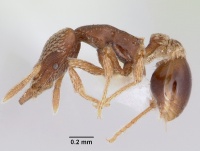Strumigenys undras
| Strumigenys undras | |
|---|---|

| |
| Scientific classification | |
| Kingdom: | Animalia |
| Phylum: | Arthropoda |
| Class: | Insecta |
| Order: | Hymenoptera |
| Family: | Formicidae |
| Subfamily: | Myrmicinae |
| Tribe: | Attini |
| Genus: | Strumigenys |
| Species: | S. undras |
| Binomial name | |
| Strumigenys undras Bolton, 2000 | |
Known from a small number of specimens. Collection details show specimens were found in litter-samples from rainforest and humid forest.
Identification
Bolton (2000) - A member of the Strumigenys biroi-group. This species is immediately distinguished from both Strumigenys biroi and Strumigenys pulchra as it lacks promesonotal sculpture, has no flagellate hairs anywhere on its body and has a normal, rather than a thick and densely spongiform, lamella on the propodeal declivity. The cephalic ground-pilosity of undras is broader and more conspicuous than in the other two species, and its promesonotal ground-pilosity hairs are very different from those seen on the head, whereas in both biroi and pulchra individual hairs of the cephalic and promesonotal ground-pilosities are similar.
Like undras, Strumigenys basiliska also has a smooth promesonotum and lacks flagellate hairs, but in the latter there is no propodeal lamella, the head is not reticulate-punctate and lacks flattened broad hairs, standing hairs are present on the mesonotum and first gastral tergite and the lateral lobe on the petiole node is much longer.
Keys including this Species
Distribution
Latitudinal Distribution Pattern
Latitudinal Range: -8.766670227° to -12.73333333°.
| North Temperate |
North Subtropical |
Tropical | South Subtropical |
South Temperate |
- Source: AntMaps
Distribution based on Regional Taxon Lists
Australasian Region: Australia.
Indo-Australian Region: Indonesia (type locality), New Guinea, Solomon Islands.
Distribution based on AntMaps
Distribution based on AntWeb specimens
Check data from AntWeb
Countries Occupied
| Number of countries occupied by this species based on AntWiki Regional Taxon Lists. In general, fewer countries occupied indicates a narrower range, while more countries indicates a more widespread species. |

|
Estimated Abundance
| Relative abundance based on number of AntMaps records per species (this species within the purple bar). Fewer records (to the left) indicates a less abundant/encountered species while more records (to the right) indicates more abundant/encountered species. |

|
Biology
Castes
Nomenclature
The following information is derived from Barry Bolton's Online Catalogue of the Ants of the World.
- undras. Strumigenys undras Bolton, 2000: 752, fig. 517 (w.q.) INDONESIA (Aru I.)
Unless otherwise noted the text for the remainder of this section is reported from the publication that includes the original description.
Description
Worker
Holotype. TL 2.1, HL 0.58, HW 0.43, CI 74, ML 0.16, MI 28, SL 0.27, SI 63, PW 0.25, AL 0.60. Dorsolateral margin of head with a closely applied row of broadly spatulate to spoon-shaped hairs, without freely laterally projecting hairs anywhere on margin. Cephalic dorsum finely and densely reticulate-punctate, the sculpture to some extent obscured by dense appressed very broadly spatulate ground-pilosity. Pronotal humeral hair absent; mesonotum without erect hairs. Ground-pilosity on promesonotum of a few scattered minute appressed hairs, much smaller, sparser and more slender than on head. Entire dorsum of alitrunk smooth and shining, contrasting strongly with the head. Side of alitrunk entirely unsculptured, smooth. Propodeum with teeth that are subtended on the declivity by lamellae, the latter not thickly spongiform. In dorsal view the propodeum terminates in the teeth, not in a pair of posteriorly directed thick spongiform lobes. Dorsal (outer) surfaces of middle and hind basitarsi without erect flagellate hairs. With petiole in profile the lateral spongiform lobe confined to the posterior portion of the node. Disc of postpetiole smooth and shining. Dorsum of petiole node and its dorsolateral margins, sides and posterior margin of postpetiole disc, and surface of limbus, all with broadly spatulate appressed hairs; those on waist segments directed posteriorly but those on limbus directed anteriorly. Standing hairs absent from first gastral tergite.
Paratypes. TL 2.1, HL 0.57-0.60, 0.43-0.45, CI 74-76, ML 0.16-0.18, MI 28-31, SL 0.26-0.28, SI 60-65, PW 0.25-0.27, AL 0.60-0.61 (5 measured).
Type Material
Holotype worker (top specimen of two on pin), Indonesia: Aru I., Kola, Wafam, 50 m., humid forest leaf litter #2, F911202, 5.32°S, 143.40°E, 27.viii.1991 (D. Agosti) (Musee d'Histoire Naturelle Genève).
Paratypes. 7 workers and 1 queen with same data as holotype (MHNG, The Natural History Museum).
Type Material
- Holotype, worker, Wafam, Kola, Aru Island, Indonesia, Musee National d'Histoire Naturelle.
- Paratype, workers, Wafam, Kola, Aru Island, Indonesia, The Natural History Museum.
- Paratype, workers, queen, Wafam, Kola, Aru Island, Indonesia, Musee National d'Histoire Naturelle.
References
- Bolton, B. 2000. The ant tribe Dacetini. Memoirs of the American Entomological Institute. 65:1-1028. (page 752, worker described)
References based on Global Ant Biodiversity Informatics
- Bolton, B. 2000. The Ant Tribe Dacetini. Memoirs of the American Entomological Institute 65
- CSIRO Collection
- Janda M., G. D. Alpert, M. L. Borowiec, E. P. Economo, P. Klimes, E. Sarnat, and S. O. Shattuck. 2011. Cheklist of ants described and recorded from New Guinea and associated islands. Available on http://www.newguineants.org/. Accessed on 24th Feb. 2011.

